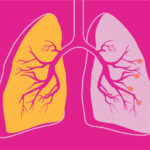
Asthma is a chronic (long-term) disorder that affects the airways in the lungs. The airways are tubes that carry air in and out of your lungs. If you have asthma, the airways can sometimes become narrowed.
Asthma concerns people of all ages and usually begins during childhood age. You may wheeze, cough, or feel uneasy in your chest. These symptoms can vary from mild to extreme and can happen every day or occasionally. Certain things can worsen asthma symptoms, such as cold weather. These are called asthma triggers. When symptoms get worse, it is called an asthma attack.
An asthma action schedule can help you manage your asthma. The plan may include monitoring, avoiding triggers, and using proper medicines.
What’s an asthma attack?
When you breathe naturally, muscles around your airways relax, letting air pass easily.
During an asthma attack, three things can occur:
- Bronchospasm: The muscles near the airways constrict (tighten). When they are tightened, it makes the airways thin. Air cannot flow freely through narrowed airways.
- Inflammation: The airway linings become bloated. Bloated airways don’t allow much air in or out of the lungs.
- Mucus production: During the attack, your body builds more mucus. This thick mucus blocks airways.
What kinds of asthma are there?
Healthcare providers identify asthma as intermittent (comes and goes) or persistent (lasting). Persistent asthma can be temperate, moderate, or brutal. Healthcare providers base asthma severity on how frequently you have attacks. They also consider how okay you can do things during an attack.
Asthma can be:
Allergic: Some allergies can provoke asthma attacks. Molds, pollens, and other allergens can induce an attack.
Non-allergic: Outside factors can cause asthma to flare up. Exercise, stress, illness, and weather may cause a flare.
Symptoms
Asthma symptoms differ from person to person. You may have irregular asthma attacks, have symptoms only at specific times such as when exercising — or have symptoms all the time.
Asthma signs and symptoms include:
- Shortness of breath
- Chest tightness or pain
- Wheezing when exhaling, which is a typical sign of asthma in kids
- Trouble sleeping caused by shortness of breath, coughing, or wheezing
- Coughing or wheezing attacks that are worsened by a respiratory virus, such as a cold or the flu
Symptoms that your asthma is probably worsening:
Asthma signs and symptoms that are more frequent and annoying
Rising difficulty breathing, as estimated with a device used to check how well your lungs are working (peak flow meter)
The need to use a fast-relief inhaler more often.
Cure
Asthma symptoms and severity are constantly changing. Tracking your plan will help you avoid asthma attacks and minimize the disturbances caused by asthma symptoms.
Meet your doctor regularly to review your treatment. Take your asthma diary and action plan with you so that you can check them with your doctor and make any needed changes to your treatment plan.
Here are some reasons why you might need to adjust your medications:
- If you’re still having bothersome symptoms even though you’re following your plan, talk to your doctor about possibly raising or changing your medications.
- If your asthma is well-controlled, you may be able to decrease the dose of medicine you take.
- If you have seasonal allergy triggers, your asthma medication may need to be increased at certain times of the year.
Modify treatment according to your asthma action plan
When your lungs aren’t working as well as they should be, you may need to modify your medications according to the plan you made with your doctor ahead of time.
The chart below can help you determine if you’re doing an excellent job of keeping your asthma under control. A similar system should be included in your asthma action plan. Depending on where your asthma control falls on the chart, you may need to modify your medications.
Long-term control medications such as inhaled corticosteroids are essential to keep asthma under control. These preventive medications treat the airway inflammation that leads to asthma symptoms. Used on a daily basis, these medications can reduce or eliminate asthma flare-ups.
Quick-relief inhalers contain a fast-acting medication such as albuterol. These medications are sometimes called rescue inhalers. They are used as needed to open your airways and make breathing easier quickly. Knowing when to use these cures can help prevent an impending asthma attack.
If you frequently use a quick-relief inhaler to treat symptoms, your asthma isn’t under control. See your doctor about making cure changes.
Make sure you know how to use your asthma medications properly. They will only keep your asthma under control if you use them correctly.



